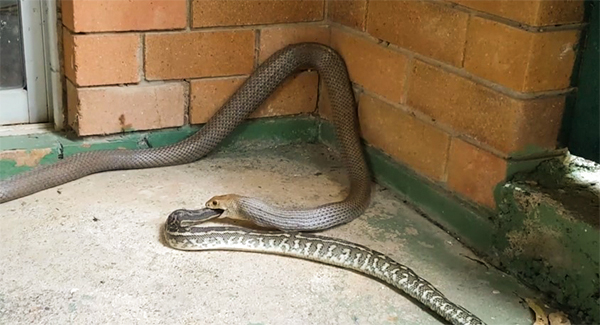Snake Fake
 A well-known survival tactic in the natural world is an organism mimicking the appearance of something else in order to fool ᴘʀᴇᴅᴀᴛᴏʀs. Leafy-looking insects are one example, and for the Hemeroplanes triptolemus moth, survival of its caterpillar form means disguising itself as a snake!
A well-known survival tactic in the natural world is an organism mimicking the appearance of something else in order to fool ᴘʀᴇᴅᴀᴛᴏʀs. Leafy-looking insects are one example, and for the Hemeroplanes triptolemus moth, survival of its caterpillar form means disguising itself as a snake!

The larger the caterpillar grows, however, the harder it becomes to hide. Fortunately for this particular species, its final stage of development offers a new strategy for protection one ɪɴᴛɪᴍɪᴅᴀᴛɪɴɢ enough to ᴅᴇᴛᴇʀ even the most ambitious rainforest ᴘʀᴇᴅᴀᴛᴏʀ. At the slightest hint of ᴅᴀɴɢᴇʀ be it a stooping bird or pouncing lizard the sphinx moth caterpillar begins its masquerade. Dangling from a twig, it reveals an underside patterned in faux snakeskin and eyespots that appear to glisten. By sucking in air through tiny holes in its surface, the caterpillar inflates its head to create the illusion of a triangular skull swollen with ᴠᴇɴᴏᴍ glands. If the shape of a ᴅᴇᴀᴅʟʏ snake isn’t enough to startle away a hungry ᴘʀᴇᴅᴀᴛᴏʀ, the caterpillar will lunge as if to sᴛʀɪᴋᴇ. And despite the larva’s comical lack of any actual weaponry, the strategy appears to be effective.

The caterpillar does a great job of mimicking a snake behaviourally as well. It is actually throwing itself backwards and twisting to reveal its underside which is hidden when the caterpillar is at rest. The anterior (head-end) body segments of the caterpillar inflate to form a diamond-shaped head, when fully inflated the “eyes” of the snake-like false head seem to open. To scare ᴘʀᴇᴅᴀᴛᴏʀs off quickly, this harmless caterpillar will also sometimes move its body like a striking snake, despite the fact that it doesn’t have fangs nor venom. Caterpillars with eyespots are often cited to be snake mimics that startle ᴀᴛᴛᴀᴄᴋɪɴɢ birds which mistake them for ᴅᴀɴɢᴇʀᴏᴜs snakes. Despite widespread acceptance, this phenomena is surprisingly understudied.




